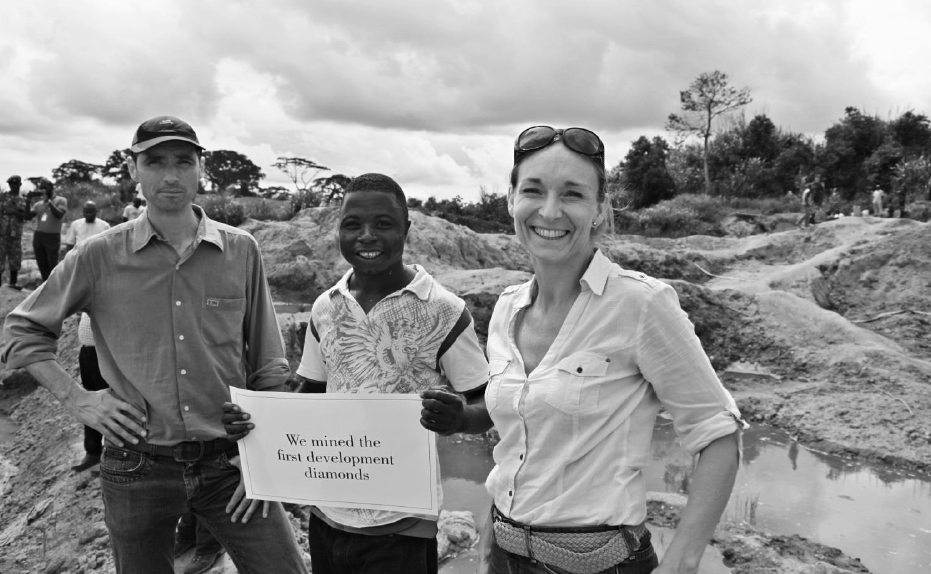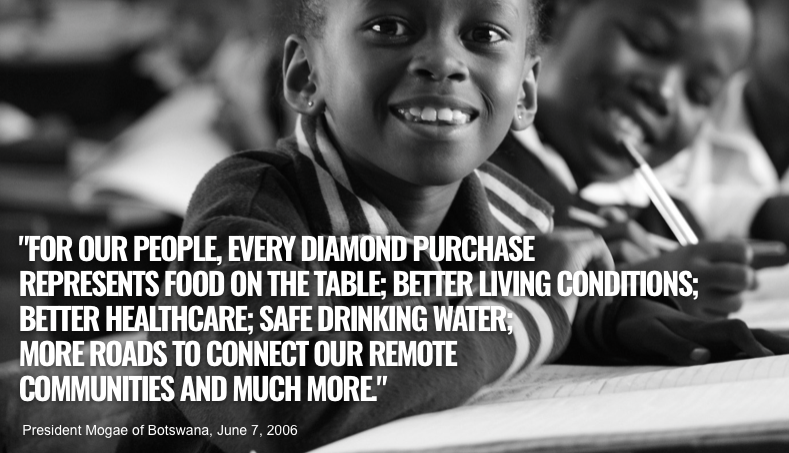Positive Impact of Diamonds on Producing Countries

Changing the narrative
There can be no doubt that mining, executed responsibly, is a significant force for sustainable growth. Beyond the beneficial effects on employment, livelihoods and the national economy, it should not be underestimated that entire communities are directly and often exclusively dependent on the sustainability and growth of the mining sector. This is no less true of diamond mining operations than any other sector, yet the general public - perhaps due to a certain blockbuster film back in 2006 - has long singled out the diamond mining industry for criticism ... perhaps while using a smartphone filled with precious metals and rare earths, from gold to battery acid.
While there was no doubt good reason to point fingers at the diamond industry before and around the turn of the century - as diamond mines were seized by warring factions and exploited to fund bloody conflicts - it has cleaned up its act significantly since then. Not only has the Kimberley Process succeeded in reducing the share of conflict diamonds to less than one percent of global production (from an estimated 15%), the industry has widely embraced the 21st-century emphasis on CSR and sustainability. The diamond mines developed this century are sophisticated, high-tech and sustainable operations, built only after extensive negotiations and contractual benefits to local populations.
Because of the disconnect between perception and reality, there is a need to change the narrative surrounding the diamond industry. People need to know about the good that diamonds do, and that miners, manufacturers and jewelers are contributing to uplift those less fortunate. A quick primer on the benefits of the diamond industry, from healthcare to infrastructure and eduction, is available at the diamondfacts.org website, but the real message is the failure to promote the message - and this must change ... not just to show that the industry is doing the right thing, but that doing the right thing is good for business as well, since customers demand it.

Just the facts, ma'am
- An estimated 10 million people are directly or indirectly supported by the diamond industry globally
- An estimated 5 million people have access to appropriate healthcare globally due to revenues from the diamond industry
- 99% of the global supply of diamonds is produced by Kimberley Process participants
- The diamond trade contributes approximately $7.6 billion per year to Africa
- Diamonds account for 88% of Botswana’s export revenue, 35% of government revenue and 20% of the gross domestic product (GDP)
- Diamonds account for approximately 48% of Namibia's export revenue, 59% of government revenue and 21% of GDP.
- Canada is the world’s third largest producer of diamonds producing an estimated US$1.7 billion worth of diamonds each year. Mining is the largest private sector employer of Aboriginal and First Nations peoples in Canada on a proportional basis, and employment is poised to increase.
- Indian and Northern Affairs Canada estimated (back in 2004) that over the life of the diamond mines in the Northwest Territories (NWT), the mining projects would collectively generate royalties of US$1.6 billion, over US$2 billion in federal business taxes , territorial taxes of US$1 billion, and employee and other business income taxes of US$3.7 billion. Diamond mining revenues have increased substantially since then.
- In Russia, the diamond industry commits over $120 million annually to help the national institutions of health, education and culture, to support socio-economic development of regions, charitable and sponsorship projects for local communities. In addition, the diamond industry allocates more than $200 million on social programs for diamond industry employees and their families, including housing, health, culture and sports, non-state pension provision. Diamond mine employees are paid 3x the average national wages.
- The diamond region of Yakutia in Russia's northeast - the largest diamond producing region in the world - receives more than $1 billion in taxes and royalties from ALROSA's diamond mining operations.
- War-torn countries such as Sierra Leone receive major economic benefits due to revenues from diamonds. Sierra Leone exported more than $154 million worth of diamonds in 2015. These diamond revenue funds are helping to rebuild its infrastructure, health services and education systems.
- All the major miners, such as De Beers and ALROSA, have extensive social development programs to benefit the local populations. These include education, training, local facilities and infrastructure, among others. 25% of De Beers employees are women.
- In Australia, the Indigenous Land Use Agreement that traditional (Aboriginal) owners negotiated with Rio Tinto's Argyle diamond mine between 2003 and 2005 was held up as an example of best practice across the country, In 2013, they had a workforce of 499 people and 43% of these were local. As of 2010, Argyle was outsourcing work to 48 indigenous contractors. In 2013 the amount spent on local indigenous businesses was over AUD $8.7 million.

Diamond Development Organizations
The vast majority of the world’s diamonds come from sources that use the revenues generated by diamonds to aid their national development. Given good governance and appropriate laws, diamonds are a vital source of revenue for building infrastructure and essential social services such as hospitals and schools. But governments are not always up to the task on their own. In addition to the contributions made by mining companies, these are a few of the many organizations that step up to ensure diamonds are delivering on the promise of benefits to the producing countries.
Diamond Development Initiative
For 10 years, the Diamond Development Initiative (DDI) has been working to transform artisanal diamond mining into an economically viable, socially and environmentally responsible activity that will benefit miners, their communities and their governments, and consequently, the diamond and jewelry industry.
Through DDI’s innovative and effective programming, more than 200,000 miners have been registered in the DRC, 10 miners’ cooperatives have been formed and legalized, 121 children in mining communities have been given access to remedial education, 13 mining operations have been certified compliant to the Maendeleo Diamond Standards in Sierra Leone, and several previously mined sites have been environmentally rehabilitated. Ethical artisanally-mined diamonds have now reached the international market.
Artisanal miners, especially in the DRC and Sierra Leone, are benefitting from registration, licensing, training and access to markets. Mining operations are safer and more environmentally-friendly.
The Responsible Jewellery Council is a not-for profit, standards setting and certification organization. It has more than 1,000 member companies that span the jewelry supply chain from mine to retail. RJC members commit to and are independently audited against the RJC Code of Practices – an international standard on responsible business practices for diamonds, gold and platinum group metals. The Code of Practices addresses human rights, labour rights, environmental impact, mining practices, product disclosure and many more important topics in the jewellery supply chain.
Founded in 2007 by leaders in the diamond and jewelry industries, the Diamond Empowerment Fund (D.E.F.) is a global nonprofit organization whose mission is to support initiatives that develop and empower people in diamond communities worldwide. They believe education is a key component to sustainable development, which in turn is essential to empower individuals, communities, and society toward future economic prosperity, stability, and advancement.
D.E.F. supports four beneficiary organizations in Africa and India, including: African Leadership Academy in South Africa; Botswana Top Achievers Program in Botswana, The Diamond Development Initiative in DRC, the Flaviana Matata Foundation in Tanzania and Veerayatan’s Colleges of Pharmacy, Engineering & Business Administration, in India.
Case Study - Botswana, or: how diamonds transformed a country
According to the World Bank, over the past 50 years, Botswana's economy has been one of the greatest success stories in the world. Botswana gained independence in 1966; at independence it was one of the poorest countries in the world, with per capita income of just $70 a year. (yes, you read that right). There were only 12 kilometers of paved roads, and agriculture (mostly cattle farming) accounted for 40% of gross domestic product (GDP).
Today, Botswana is among the most prosperous countries in Africa, with a real middle class and a per capita income of over $7,500 a year. According to GDP PPP (purchasing power parity), Botswana now has a per capita of about $18,825, making Botswana an upper- middle-income country comparable to Chile or Mexico. By 2007 Botswana had 7,000 kilometers of paved roads. Its success is also evident in other measures of human development. At independence, life expectancy at birth was 37 years. By 1990 it was 60, 10 years above the African average. Under-five mortality had fallen to about 45 per 1,000 live births in 1990, compared with 180 for Africa as a whole.
What brought about this huge change in the fortunes of Botswana? There is no question that the discovery of diamonds was the most important catalyst in Botswana’s economic growth. In 1967, the year after Botswana gained its independence from Britain, a huge diamond mine was discovered in a remote area called Orapa, about 250 miles from the capital city of Gaborone. The company that found the mine was De Beers. Due to De Beers’s own sense of corporate social responsibility, they did not simply plunder Botswana. Practically from the start, it entered into a 50-50 joint venture with the government; about a twenty years ago, it also sold the government a 15 percent stake in the company.
It has also built roads, hospitals and schools in Botswana; worked to help the country deal with H.I.V. and AIDS; and been involved in and paid for a hundred other things that have helped make Botswana an African success story. Most of the executives in the government-company joint venture are black Africans who have been trained by De Beers. Years ago, the company closed its diamond sorting facility in London and opened the largest, most technologically advanced diamond sorting complex in the world in Gaborone. It employs 600 people and is also part of the company’s 50-50 joint venture with the government.
Diamonds now represent 88% of the total exports of Botswana. Its diamond industry currently contributes 35% of its income to fiscal revenue and around 20% to GDP. This makes the diamond industry – mining, cutting and polishing, and sales – the most important economic activity for the country. Botswana's issue now is to diversify the economy, as too much reliance on a single commodity is not a recipe for a sustainable economy, but the fact that Botswana now has the capacity to diversify is almost wholly attributable to diamonds. And its success with diamonds is a good sign: through good governance, it has avoided the 'resource curse', which names how many countries in Africa have squandered vast amounts of their natural wealth. Most of the credit for the fact that Botswana did not must be given to the country's leadership, which, since independence, has designed and fostered the conditions of governance that have ensured stability and social and economic progress.


